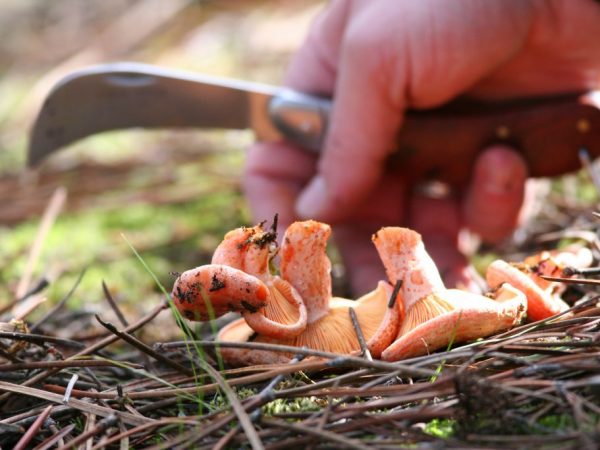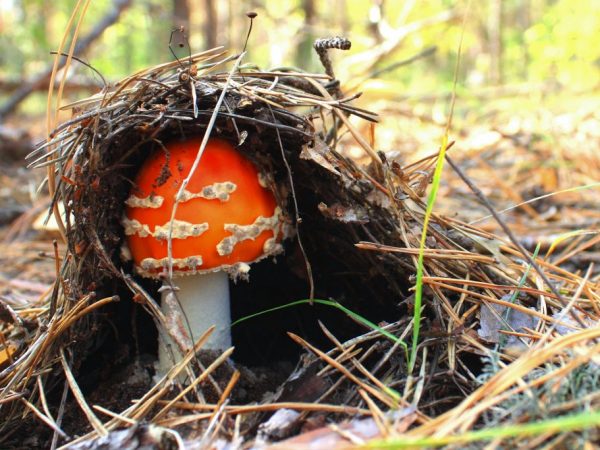Pine forest mushrooms
Each representative of the mushroom kingdom needs special conditions for growth: climate, neighborhood with certain trees, terrain, soil composition, etc. The mushrooms of the pine forest, represented by a large number of species, owe their diversity to the unique natural conditions that appeared during the formation of such a specific biogeocenosis ...

Pine forest mushrooms
Natural conditions of pine forests
The pine forest generates phytoncides, so the air in it is considered curative and helps in the healing of lung diseases.
By the way. Phytoncides are volatile compounds that can kill or slow down the development of microorganisms. Pine is able to grow in the harsh northern climate on the poorest soils: both sandy with a lack of moisture and swampy.
In pine forests, mushrooms grow abundantly, forming mycorrhiza also with shrubs, ferns and grasses, linking them together. Pine trees provide sunlight access to the soil surface and do not impede the circulation of air currents. The above-ground cover is represented by green mosses, blueberry, lingonberry, and juniper bushes.
The role of fungi in the coniferous forest is great, due to their vital activity, the decomposition of pine needles (which make up the forest litter), dead wood and dry broken branches occurs. Mushrooms grow under the pine trees, giving them the micronutrients and carbohydrates produced by the mushroom hyphae and receiving nutrients from the roots in return.
Types of edible mushrooms
The species of representatives of the mushroom kingdom growing under the pines depend on the age of the tree. Mushrooms grow under a pine tree on moist soil, along clearings, glades. Under young two-year-old trees, there is a late oiler, the yield of which reaches a maximum at 12-15 years of life of the pine. When the grass cover is replaced by a layer of needles, they are looked for under it along the noticeable tubercles.
In the grown pine plantations, greenfinch begins to bear fruit abundantly, hiding in low-lying places under a layer of needles. On broken, old and fallen trees, groups of honey agarics grow, and on more flat terrain, you can find a gray ryadovka, porcini mushroom, camelina and some other varieties:
- White, or boletus: the most valuable representative of the Boletov family. The fruit body is fleshy. The hat is from 8 to 25 cm in diameter, hemispherical, brownish brown. The pulp is white with a pleasant smell; it does not change color on the cut. The leg is thick - from 7 to 16 cm, has a light cream color and a barely noticeable mesh on the surface. Prefers pine forests with light sandy soil. Fruiting from June to October.
- Pine honey mushroom, or honey mushroom yellow-red: it is a representative of the Ryadovkovye family, growing on stumps of pine and other conifers in small groups from July to early October. It has a small, slightly convex cap with a matte scaly and velvety surface, the color is orange-red. The leg is the same color, it is thin and slightly curved, 5-7 cm in height.
- Ryzhiki: representatives of the genus Millechniki got their name due to their bright red color with a reddish tint, which is explained by the high content of beta-carotene in them. A hat with concentric rings and edges turned down is 5-12 cm in diameter. The leg is of the same color, extended upward, 4 to 10 cm long. The pulp is dense, greening at the fracture site, secreting light orange milky juice. It grows under the pine trees, buried in the coniferous litter. Mass collection falls on July - September.
- Greenfinch, or row green: a small mushroom with a wide open head of a greenish tint. Its diameter reaches 15 cm, in the center it is covered with small scales. The leg is short, 4-5 cm high. The pulp is white, with age it acquires a yellowish tint. On the cut, the color does not change. Grows under pines in groups of 5-8 from September to November.
- Chanterelles: bright mushrooms growing in pines and having a yellow-orange color. A hat with wavy edges is 2-12 cm, flat-concave in the center. The pulp is fleshy, fibrous in the stem. The leg itself is lighter, smooth and tapers at the bottom. Not affected by pests. Harvesting begins in June, then August - September. Distributed mainly in coniferous forests.
- The load is white, or russula excellent: one of the species of the Russula family, growing in light coniferous forests. Large, the cap reaches a diameter of 18 cm, the color is white with rusty spots on the surface. The surface is open and has a funnel in the center. The leg is strong, has the same color as the cap, narrowed at the bottom. The pulp is juicy and has a pleasant smell. It grows from mid-summer to mid-autumn.
- Flywheels: do not differ in high taste. Variegated, red and green mushrooms are good for food. They have a dry, slightly velvety cap about 9 cm in diameter, which cracks as they age. The color ranges from yellow to brownish brown. The leg of a lighter color has a cylindrical shape, reaches a height of 8 to 14 cm. The pulp is dense, the aroma is pleasant. However, unlike other members of the group, polish mushroomgrowing in pines and other coniferous forests has good organoleptic characteristics.
- Row purple: conditionally edible mushroom of unusual bright purple color. Its cap reaches 15 cm in diameter; in adult specimens it is flat, slightly concave in the center and curved at the edges. The stem is cylindrical, with a thickening at the base. The pulp is dense, the same light purple hue. They are saprophytes and grow in pines and other conifers on decaying coniferous litter.
Poisonous representatives

Amanita muscaria cause severe poisoning
Not only edible mushrooms grow under the pines. There are also poisonous representatives: waxy talker, pale toadstool, varieties of fly agaric and false sulfur-yellow honey fungus. Their toxins, entering the human body, affect the central nervous system, liver, kidneys and digestive system. Without timely qualified medical care, poisoning will be fatal.
In order not to be at risk of poisoning when eating mushrooms, you need to know the features of the dangerous representatives of the mushroom kingdom.
- Death cap: is considered the most dangerous poisonous forest mushroom, the toxins of which manifest themselves after a while. The olive cap is 5 to 15 cm in diameter and has a hemispherical shape and fibrous skin. The leg is cylindrical, there is a "pouch" at the base. The pulp is white, does not change color when damaged, the smell is weak.
- Amanita muscaria, red and grebe: have thick, fleshy caps ranging from white to green. On top of them there are the remnants of a blanket in which the fruit body of a young specimen was enclosed. They resemble white flakes. The leg is straight, widened downwards. The pulp is light, with a pronounced odor. Contains strong toxins.Amanita muscaria is capable of having a hallucinogenic effect.
- Sulfur-yellow honey fungus: false relative of edible mushrooms. It is a small mushroom that grows in small groups on stumps and rotten wood. The caps are light yellow at the edges, darkening in the center, with a diameter of 2 to 7 cm. The yellowish-white flesh is characterized by a persistent unpleasant odor. The leg is thin and long. It differs from the edible species in the greenish color of the fruiting body.
- Waxy talker: a poisonous representative of the Ryadovkovy family. It has a white-cream wide cap with a tubercle in the center and weak concentric circles on its surface. The leg is long, widened at the bottom, with a pubescent surface, 3-4 cm in height. The pulp is white with a creamy shade, dense, with a pleasant aroma. Contains a high concentration of muscarine, which is not destroyed by heat treatment.
Irina Selyutina (Biologist):
The waxy talker got its name from the presence of a white waxy layer on the surface of the cap of a flesh or brownish color. Over time, this waxy coating cracks and forms a kind of "marble" surface. The skin can be easily removed, right up to the center of the cap. The mushroom is poisonous and contains muscarine, which is not destroyed during heat treatment. It was experimentally found that the destruction of the muscarine alkaloid is possible at temperatures exceeding 100 ℃ with the appearance of a slight smell of tobacco. When eating large doses of the waxy govorushka, death is noted somewhere in the range of 2-3% after 6-12 hours.
If, after eating mushrooms, you notice symptoms of poisoning with poisonous mushrooms in yourself or your loved ones, consult a doctor immediately.
Conclusion
The pine forests are full of a variety of mushrooms. The collection of these gifts of nature should be treated with care and attention. A mushroom from a pine forest is both edible and poisonous.



